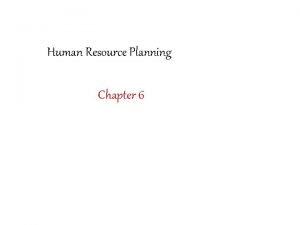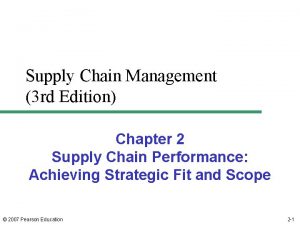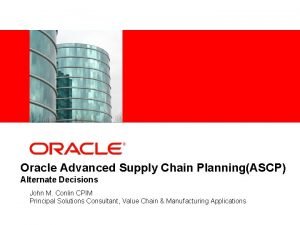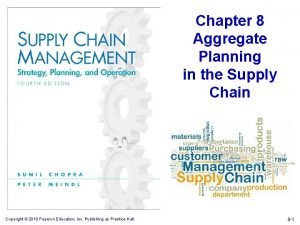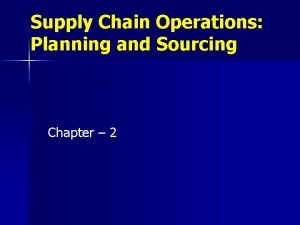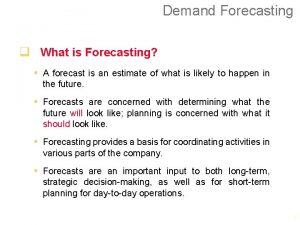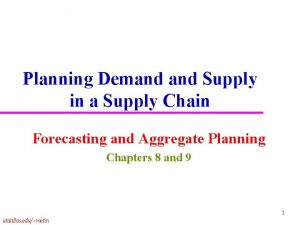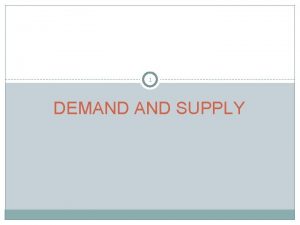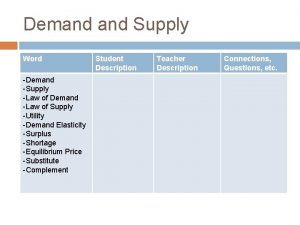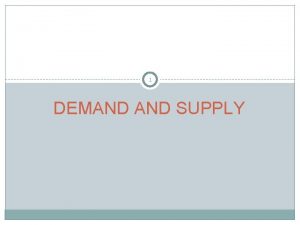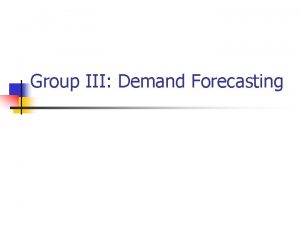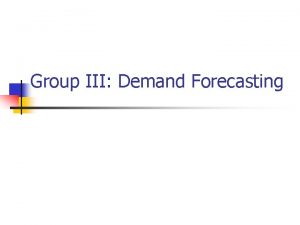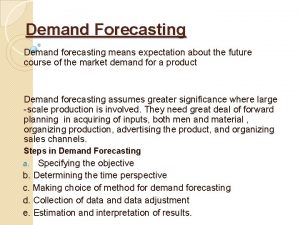Planning Demand Supply in a Supply Chain Forecasting



















- Slides: 19

Planning Demand Supply in a Supply Chain Forecasting and Aggregate Planning Chapter 8 1 utdallas. edu/~metin

Aggregate Planning (Ag-gregate: Past part. of Ad-gregare: Totaled) u u If the actual is different than the plan, why bother sweating over detailed plans Aggregate planning: General plan for our frequency decomposition – Combined products = aggregate product » Short and long sleeve shirts = shirt u Single product » AC and Heating unit pipes = pipes at Lennox Iowa plant – Pooled capacities = aggregated capacity » Dedicated machine and general machine = machine u Single capacity – E. g. SOM has 100 instructors – Time periods = time buckets » Consider all the demand production of a given month together u utdallas. edu/~metin u When does the demand or production take place in a time bucket? Increase the number of time buckets; decrease the bucket length. 2

Fundamental tradeoffs in Aggregate Planning Capacity: Regular time, Over time, Subcontract? Inventory: Backlog / lost sales, combination: Customer patience? Basic Strategies u Chase (the demand) strategy; produce at the instantaneous demand rate – fast food restaurants u Level strategy; produce at the rate of long run average demand – swim wear u Time flexibility; high levels of workforce or capacity – machining shops, army u Deliver late strategy – spare parts for your Jaguar utdallas. edu/~metin 3

- Which is which? Level Deliver late Chase Time flexibility Matching the Demand pa ci ty Adjust the capacity to match the demand Use inventory U se ca Demand Use delivery time utdallas. edu/~metin Demand 4

Capacity Demand Matching Inventory/Capacity tradeoff u Level strategy: Leveling capacity forces inventory to build up in anticipation of seasonal variation in demand u Chase strategy: Carrying low levels of inventory requires capacity to vary with seasonal variation in demand or enough capacity to cover peak demand during season 5 utdallas. edu/~metin

Case Study: Aggregate planning at Red Tomato u Farm tools: u Shovels u Spades Same characteristics? Generic tool, call it Shovel u Forks Aggregate by similar characteristics utdallas. edu/~metin 6

Aggregate Planning at Red Tomato Tools 7 utdallas. edu/~metin

Aggregate Planning What is the cost of production per tool? That is materials plus labor. Overtime production is more expensive than subcontracting. 8 What is the saving achieved by producing a tool in house rather than subcontracting? utdallas. edu/~metin

1. Aggregate Planning (Decision Variables) Wt = Number of employees in month t, t = 1, . . . , 6 Ht = Number of employees hired at the beginning of month t, t = 1, . . . , 6 Lt = Number of employees laid off at the beginning of month t, t = 1, . . . , 6 Pt = Production in units of shovels in month t, t = 1, . . . , 6 It = Inventory at the end of month t, t = 1, . . . , 6 St = Number of units backordered at the end of month t, t = 1, . . . , 6 Ct = Number of units subcontracted for month t, t = 1, . . . , 6 Ot = Number of overtime hours worked in month t, t = 1, . . . , 6 Did we aggregate production capacity? 9 utdallas. edu/~metin

2. Objective Function: 3. Constraints u. Workforce size for each month is based on hiring and layoffs u. Production (in hours) for each month cannot exceed capacity (in hours) 10 utdallas. edu/~metin

3. Constraints u Inventory balance for each month Period t-1 Period t+1 11 utdallas. edu/~metin

3. Constraints u Overtime for each month 12 utdallas. edu/~metin

Execution u Solve the formulation, see Table 8. 3 – Total cost=$422. 275 K, total revenue=$640 K u Apply the first month of the plan Delay applying the remaining part of the plan until the next month Rerun the model with new data next month u This is called rolling horizon execution u u 13 utdallas. edu/~metin

Aggregate Planning at Red Tomato Tools This solution was for the following demand numbers: What if demand fluctuates more? utdallas. edu/~metin 14

Increased Demand Fluctuation Total costs=$432. 858 K. 16000 units of total production as before why extra cost? utdallas. edu/~metin With respect to $422. 275 K of before. 15

Summary u Qualitative strategies of matching demand supply u Quantitative methods 16 utdallas. edu/~metin

Material Requirements Planning u Master Production Schedule (MPS) u Bill of Materials (BOM) u MRP explosion u Advantages – Disciplined database – Component commonality u Shortcomings – Rigid lead times – No capacity consideration 17 utdallas. edu/~metin

Optimized Production Technology u Focus on bottleneck resources to simplify planning u Product mix defines the bottleneck(s) ? u Provide plenty of non-bottleneck resources. u Shifting bottlenecks 18 utdallas. edu/~metin

Just in Time production u u u u Focus on timing Advocates pull system, use Kanban Design improvements encouraged Lower inventories / set up time / cycle time Quality improvements Supplier relations, fewer closer suppliers, Toyota city JIT philosophically different than OPT or MRP, it is not only a planning tool but a continuous improvement scheme 19 utdallas. edu/~metin
 Matching supply and demand in supply chain
Matching supply and demand in supply chain Methods of demand estimation in managerial economics
Methods of demand estimation in managerial economics Chain ratio method
Chain ratio method Chain ratio method of demand forecasting
Chain ratio method of demand forecasting What is collaborative demand planning
What is collaborative demand planning Human resource planning definition
Human resource planning definition Module 5 supply and demand introduction and demand
Module 5 supply and demand introduction and demand Zone of strategic fit
Zone of strategic fit Eltonian pyramid
Eltonian pyramid What is logistics management
What is logistics management Advanced planning command center
Advanced planning command center Aggregate planning strategies in supply chain management
Aggregate planning strategies in supply chain management Supply chain vision
Supply chain vision Supply chain operations planning
Supply chain operations planning Objectives of outsourcing
Objectives of outsourcing Hotel demand forecasting
Hotel demand forecasting Statistical methods of demand forecasting
Statistical methods of demand forecasting Types of forecasting
Types of forecasting Statistical methods of demand forecasting
Statistical methods of demand forecasting Demand estimation and forecasting
Demand estimation and forecasting





